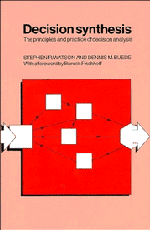9 - DECISION SYNTHESIS APPRAISED
from PART II - PRACTICE
Published online by Cambridge University Press: 16 September 2009
Summary
In this closing chapter we will appraise in three ways the decision synthesis that we have described in the other chapters. First we will discuss how we can know whether to trust the recommendations of a decision analysis — should the synthesized decision be taken, or ought we to be cautious about the limitations of our analysis? This is the study of how a decision synthesis may be validated, and it will be discussed in Section 9.1. This will involve an account of how sensitivity analysis may be used to improve the validity of an analysis and, in a rather different argument, discussion showing that, if decision synthesis is constructive, validity is less of a problem. Secondly, in Section 9.2, we shall discuss what needs to be done to make decision synthesis a yet more effective procedure for enhancing decision-making. We shall review the research areas that, at the time of writing, seem to be the most important, and speculate on the likely changes that we might see in the practice of decision analysis in the next few decades. Finally, we conclude the book with a discussion of the ethics of doing decision synthesis.
THE VALIDATION OF DECISION ANALYSIS
When first introduced to the ideas of decision theory, many people find the structure and consistency provided by the theory very attractive, but then find great difficulty in applying the ideas to practical problems.
- Type
- Chapter
- Information
- Decision SynthesisThe Principles and Practice of Decision Analysis, pp. 271 - 281Publisher: Cambridge University PressPrint publication year: 1988



